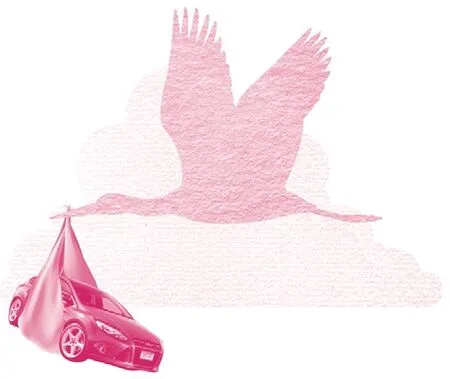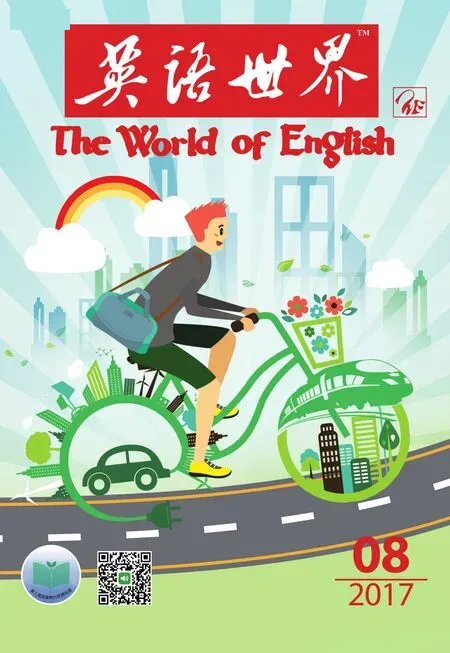Solving Transport Headaches in the Cities of 2050
文/陈志翔 译/雷婷
Solving Transport Headaches in the Cities of 2050
文/陈志翔 译/雷婷

What is the future of urban mobility2mobility移动性,机动性。? By 2050 there could be 2.5bn cars roaming the planet and most of them will be concentrated in cities, the OECD3=Organization for Economic Cooperation and Development,经济合作与发展组织,简称经合组织,由35个国家组成,旨在共同应对全球化挑战。has reported. Climate scientists predict irreversible4irreversible不可逆转的;不可取消的。environmental damage with continued carbon emissions. In fact, the transport sector attributes to5attribute to 贡献;归因于。23% of the globe’s greenhouse gas emission resulting from burning of fossil fuels.
[2]There are four remedies6remedy补救方法;治疗方法。to combat this polluting chaos. One approach is the electri fi cation of the automobile.Another is vehicle sharing. Third is the creation of self-drive vehicles. And the fourth is increased usage of low-energy transportation options like walking, bicycling, and use of mass transit7transit运输;载运。.
[3]Electric vehicles (EVs) are primarily an auto-centric, engineering approach to the problem, whereby automakers have substituted the internal combustion8combustion燃烧;氧化。engine with battery powered electric motors. This dramatically increases the fuel economy of the vehicle and eliminates tailpipe9tailpipe(汽车等的)排气尾管。emissions. The rise of Tesla Motors10一家美国电动车及能源公司,产销电动车、太阳能板及储能设备。and their commitment to create luxury electric sports cars has created positive momentum11momentum势头;动力。for EVs.Now nearly every major automaker in the world has an EV in the production pipeline. The development of new Lithium-ion battery technologies with much higher energy and power density12energy density能量密度,指每单位(重量或体积)的电池所储存的能量;power density功率密度,指每单位(重量或体积)的电池所能输出的最大功率。has also made EVs more competitive. Eventually, EVs will be designed speci fi cally around new electric drivetrains such as in-wheel electric hub13轮毂电机将动力装置、传动装置和制动装置都整合到轮毂内,大大地简化了电动车辆的机械部分。hub轮毂。motors, which eliminate the need for transmissions14transmission〈机〉变速器。and gearboxes15gearbox变速箱。, further improving both driving and environmental performance.
[4]The world’s largest car sharing program, Zipcar, based in Cambridge16坎布里奇,位于美国马萨诸塞州,哈佛大学与麻省理工学院的所在地。,near Boston, has taken a businessmodel approach, allowing users to rent vehicles by the hour. Users have the bene fi t of access to mobility whenever they need it, without the burdens of car ownership such as car depreciation, parking, insurance, tolls17toll(桥梁或道路的)通行费。, and maintenance. Zipcar estimates every shared vehicle replaces up to 20 private automobiles, thus reducing total vehicle miles and land devoted to parking.
Driver free
[5]Autonomous automobiles are no longer science fi ction. Tests have shown that the concept will work on real-life roads. Automakers such as GM, Audi,Toyota, and others have invested the concept. The Google Driverless Car has already logged18log行驶,行进(若干距离或时间)。300,000 miles on California roads without a human driver.
[6]Every year some 1.25 million people around the world die from automobile accidents. Autonomous vehicles can use car-to-car communication to avoid accidents and will always follow the road rules. Cars could be made out of lighter materials for collision-free environment to make them much more energy efficient. Autonomous vehicles can also closely follow each other, in platoon19platoon排;队。fashion, improving synchronisation20synchronisation同步;同时发生。with traffic signals to avoid stop and start delays. Estimates by some leading experts state that traffic flow could improve by as much as 40-50% just by using driverless technology. That means less idling21idling(发动机等)空转。at the traffic lights,and less pollution.
[7]The increased use of low-energy transportation options such as bicycle sharing, bus rapid transit and traditional subways are providing city dwellers with more flexible, cheaper, and less polluting options. For instance, China will be building over 87 new mass transit rail lines of nearly 2,500km of length in the next fi ve years alone. If construction continues on this pace, then China’s cities will have half of the world’s metro tracks by 2050. Some novel mass transit concepts have also emerged,such as on-demand buses developed by the University of Tokyo, which replace fixed-route bus lines, by dynamically routing22route规划路线。pick-ups23pick up中途把……带走。and drop-offs24drop off让……下车。based on user demand. These systems improve operational efficiency and reduce carbon emissions by eliminating unnecessary stops.
[8]But simply replacing a fossil fuel-burning car with an electric one—even one that can safely and ef fi ciently drive itself and collaborate with other vehicles—will not be enough unless we adopt new use and ownership models and fundamentally change urban settlement. Rapid transit offers a partial solution, but they also have limitations.Public transit systems like subways and buses are extremely effective in moving masses of people from fixed point to fi xed point. But they do not solve the first and last mile problem. Users may live too far away from transit points to walk. This problem is compounded if users have much to carry, have a physical disability, or it is simply too hot,cold, or wet. The creation of an Autonomous Mobility-on-Demand (A-MoD)network may solve this problem. Modelled after bicycle-share programmes,users will have access to a network of Lightweight Electronic Vehicles(LEVs) distributed at charging stations throughout the city. The swipe25swipe刷卡。of a smart phone allows them to pick-up an electric vehicle at a charging station and drop it off at any other station.
[9]Users can combine modes by taking a shared-autonomous LEV for short distances then transferring to any mass transit mode, finishing their trip by cycling or walking a short distance. The AMoD network would consist of a fl eet of electric bicycles, scooters26scooter小型摩托车。, and a range of electric vehicles. This essentially forms a new mobility network for shortdistance, low-speed trips that enable users to customise every single trip by selecting the appropriate vehicle for each trip segment—whether that’s to work or the local grocery store. More impor-tantly, these intermodal27intermodal多式联运的;不同运输方式之间的。systems are complementary to28be complementary to与……互补。mass transit, therefore dramatically increasing involvement in low-pollution transport schemes.
Radical re-think
[10]Unlike bicycle share programmes that suffer from redistribution problems(such as too many bikes in some locations and none in others), the A-MoD system could simply deliver a vehicle to a user. Once the user is dropped off,the shared LEV will drive on its own to pick-up another user, or to park itself for recharging. A-MoD systems essentially act as driverless electric taxis.
[11]The technologies to create smart sustainable cities have existed for a long time. Ferdinand Porsche29费迪南德·保时捷(1875—1951),又译费迪南·波尔舍,德国汽车工程师,出生于奥匈帝国的波希米亚(现为捷克一部分)。由费迪南德设计、大众汽车生产的甲壳虫车,曾是世界上以同一型号设计产量最高的汽车。developed the first hybrid vehicle30hybrid vehicle混合动力汽车。to use electric motors in 1898. But in the end, technology and progressive public policy cannot do it alone, nor can new business models. It requires that we fundamentally re-think the urban structure of our cities, so that we don’t separate our living and working to the point that we need motorised transportationin the first place. It requires walkable, high-density, mixed-use neighbourhoods where the needs of every resident are met with less than a 20-minute walk.■
城市机动性的未来是什么?据经合组织报道,到了2050年,这颗行星上将有25亿辆小汽车熙来攘往,而且它们大多集中在城市。气候科学家预测,持续的碳排放将对环境造成不可逆转的破坏。实际上,燃烧化石燃料所排放的全球温室气体有23%来自交通运输业。
[2]应对这种污染乱象,有四种补救方法:一是使用电动汽车,二是共享汽车,三是研发无人驾驶汽车,四是多使用步行、骑行以及公共交通等低能耗的交通方式。
[3]电动汽车本质上是一种以汽车为中心的工程解决方法。汽车制造商将内燃机换成由电池驱动的电动机,显著地提升了车辆的燃油经济性,消除了尾气排放。特斯拉汽车公司的崛起及其对打造豪华电动跑车的苦心孤诣为电动汽车的发展创造了积极势头。现在,世界上几乎每个主流汽车制造商的生产线上都有一款电动汽车。随着能提供更大能量密度与功率密度的新型锂离子电池技术的发展,电动汽车变得更有竞争力。最终,电动汽车将特别围绕新型电气传动系统展开设计。比如说轮毂电机,它省去了变速器和变速箱,进一步提升了驾驶性能与环保性能。
[4]世界最大的汽车共享项目Zipcar总部位于波士顿附近的坎布里奇。Zipcar已采用商业模式,允许用户按小时租车。用户无论何时需要,都可以便捷地获取车辆,不用承担车主的各种负担,诸如折旧、停车、保险、通行和维修等。据Zipcar预估,每辆共享汽车最多可以替代20辆私人汽车,由此缩减总的汽车里程,减少停车用地面积。

无人驾驶
[5]自动驾驶汽车已不再是科幻。这一概念已通过测试,将被运用到现实道路上。通用、奥迪、丰田等汽车制造商已投资了这一概念。谷歌无人驾驶汽车已在加利福尼亚州的道路上行驶了30万英里的无人驾驶里程。
[6]全球每年约有125万人死于车祸。自动驾驶汽车能利用车间通信避免车祸,同时一贯遵守道路法规。在这种无碰撞的情形下,汽车可以用更轻的材料制成,让自身更节能。自动驾驶汽车还能一排排前后紧挨,提升与交通信号的同步性,从而避免停车与起步延迟。一些权威专家预测,单靠使用无人驾驶技术就能提升40%—50%的交通流量。那意味着交通灯前的空转少了,污染也少了。
[7]共享单车、快速公交和传统地铁之类的低能耗交通方式的普及为城市居民提供了更灵活、更实惠、污染更少的出行选择。例如,中国仅在未来五年就将铺设超过87条新的城市轨道线路,总长约为2500公里。如果保持这种建造速度,截止2050年,中国城市拥有的地铁轨道将占世界的一半。一些新颖的公共交通概念也出现了,比如东京大学设计的按需公交车。它并没有固定的公交路线,而是根据用户需求动态地选定上下车地点。按需公交车系统省去了不必要的停车,从而提高了运行效率,减少了碳排放。
[8]但仅仅用电动汽车(即便是可以安全高效地无人驾驶并和其他车辆联动的电动汽车)取代燃烧化石燃料的汽车还是不够,除非我们采用新的使用模式与所有权模式,从根本上改变城市居住区。高速交通提供了部分解决方法,但也有局限。地铁和公交车之类的公共交通系统在点对点移动大量人员方面极为有效,但它们并不能解决第一公里与最后一公里的问题。用户可能住得离经停点太远,没法步行过去。而且当用户携带东西太多或者身体残疾时,或者纯粹是遭遇了高温、严寒或雨雪天气时,问题就更复杂了。自动按需移动(A-MoD)网络的创建可以解决这个问题。与单车共享项目类似,用户可以使用分散在城市各个充电站里的轻型电动汽车(LEV)。用户用智能手机支付后就可以从一个充电站把车开走,又在其他任何站点把车还回去。
[9]用户可以把这些模式结合起来,短途使用共享自动LEV,再换乘任意一种公共交通工具,最后一段路骑行或步行。A-MoD网络由一组电动自行车、小型摩托车,以及各式各样的电动汽车组成。这主要构成了适用于短途、低速行程的新型机动网络,让用户不管是去上班还是去本地杂货店,都能根据每段路程选择适合的车辆,从而个性化定制每次行程。更重要的是,这些联运系统与公共交通互补,可以显著提升低污染交通方式的参与度。
彻底反思
[10]单车共享项目饱受再分配问题之苦(比如一些地点车太多,另一些地点又没车)。A-MoD系统与其不同,可以便捷地将车辆送到用户身边。一旦用户下了车,共享LEV就会自动驾驶到另一个用户的上车点,或者自己停车充电。A-MoD系统实际上相当于无人驾驶电动出租车。
[11]创造可持续智能城市的技术由来已久。1898年,费迪南德·保时捷就研制了第一辆使用电动机的混合驱动汽车。但归根结底,无论是科技、激进的公共政策,还是新的商业模式,都无法单打独斗。这要求我们从根本上反思我们的城市结构,从一开始就不把工作区和生活区分隔得太远,远到需要机动交通的地步。这种城市结构倡导可步行、高密度、多功能的社区,让每位居民都步行不到20分钟就能到达目的地。 □
2050年的城市如何解决交通难题
ByRyan Chin1
1 陈志翔(瑞安·陈)是麻省理工学院媒体实验室(MIT Media Lab)新能源交通工具领域的专家。
(译者曾获第五届“《英语世界》杯”翻译大赛优秀奖)

